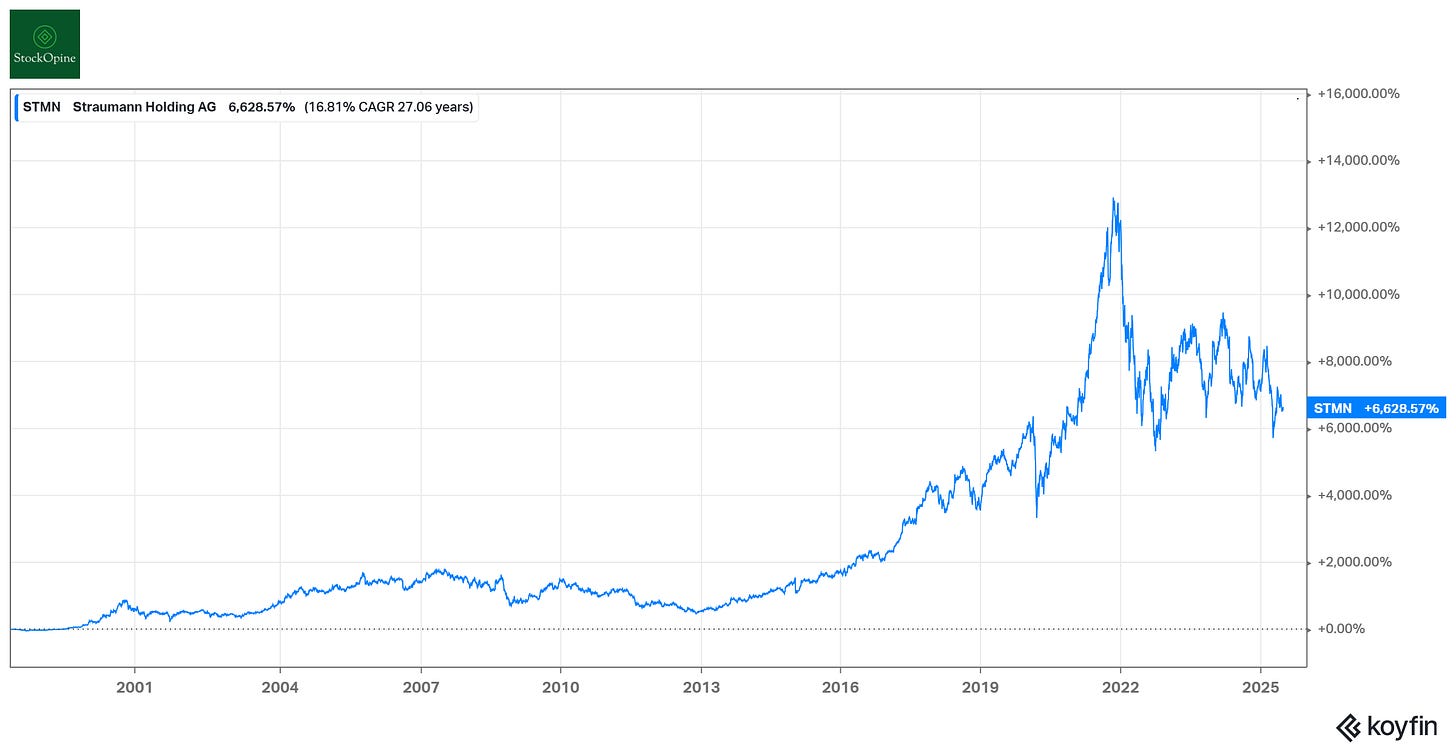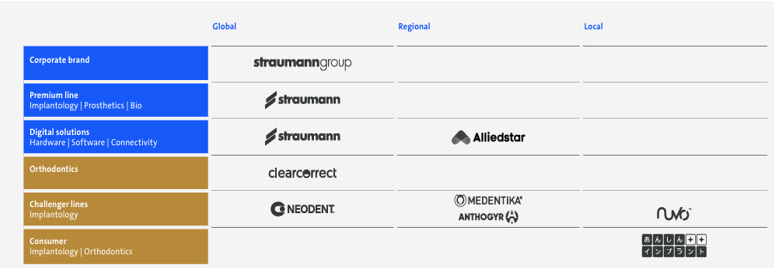Straumann: Is Now the Time to Buy This Best-in-Class Business?
A deep dive into the king of dental implants
In today’s deep dive, we will be covering the world's undisputed leader in implant dentistry, Straumann Holding AG. The dental industry is underpinned by powerful and durable tailwinds: an aging global population requiring more complex dental care, a rising middle class in emerging markets with increased discretionary income, and still-low implant penetration rates that provide a long runway for growth.
From its humble origins in a Swiss watchmaking valley, Straumann has not only led this space for decades but has consistently outpaced its peers in growth, profitability, and returns on capital.
This analysis will dissect Straumann’s multi-brand strategy, which enables it to compete effectively across all price points—from premium to value. We will also explore its strategic push into digital dentistry, a move designed to create a sticky, integrated ecosystem for dental professionals. Finally, we will benchmark Straumann against its key competitors and assess whether this high-quality company offers an attractive entry point at its current valuation.
Without further ado, let’s dive in.
Contents:
Key Facts
Business Overview
Management
Industry
Financial Analysis
Competitive Advantages, Opportunities and Risks
Valuation
Conclusion
1. Key Facts
Description: Straumann Holding AG (Ticker: STMN) is a global leader in dental implants and orthodontic solutions. The company develops, manufactures, and markets dental implants, CADCAM prosthetics, clear orthodontic aligners and digital solutions used in tooth restoration, replacement, and preservation.
Key Financials: From FY15 to FY24, Straumann achieved a revenue and operating income Compound Annual Growth Rate (CAGR) of 14%, reaching FY24 revenue of CHF 2.5 billion and operating income of CHF 625 million (25% operating margin). Straumann has debt and lease liabilities of CHF 414 million compared to cash and cash equivalents of CHF 376 million.
Price & Market Cap (as of 25 June 2025): Its market cap is CHF 16.6 billion with a 52-week low of CHF 83 and a 52-week high of CHF 141, whereas it currently trades at CHF 104.
Valuation: It trades at a LTM EV/EBITDA of 21.4x (5 Year average of 33.4x) and a LTM EV/Sales of 6.7x (5 Year average of 10.4x).
2. Business Overview
a. The Straumann Story
The history of Straumann dates back to the early 1950s, founded by Reinhard Straumann in Switzerland, it began as a research institute and family business, specializing in advanced alloys for the country's famed watchmaking industry. Its expertise in material science led to a pivotal shift in the 1960s, when the company began developing non-corroding alloys for treating bone fractures, marking its entry into medical technology.
The true turning point came in 1974 with the production of its first titanium hollow cylinder dental implants, laying the foundation for what would become the Straumann Dental Implant System. This move was solidified in 1980 with the co-founding of the International Team for Implantology (ITI), a global academic organization that has since become a cornerstone of Straumann's scientific credibility and educational outreach.
Under the leadership of the founder's grandson, Thomas Straumann, the company sharpened its focus exclusively on dental implantology in 1990. This was followed by a series of breakthrough innovations such as:
SLA Surface (1997): A revolutionary surface treatment that halved implant healing times.
SLActive Surface (2005): An even more advanced surface that further improved treatment outcomes and solidified the brand's premium reputation.
The company's 1998 IPO on the Swiss stock exchange provided the capital to fuel its ambitious global expansion and cement its market leadership.
Source: Koyfin (affiliate link with a 20% discount for StockOpine readers, premium members can benefit from a 3-month free trial)
b. Business Model: Multi-Brand Strategy and Integrated Ecosystem
Straumann's business model is centered on a multi-brand strategy designed to capture market share across all price segments and geographies. Since implant dentistry is a high-cost elective procedure rarely covered by insurance, offering a range of price points is critical for market penetration.
The flagship Straumann brand anchors the premium end of the market, commanding high prices backed by decades of clinical research and a reputation for quality.
Recognizing the threat from lower-priced competitors and the immense growth potential in emerging markets, the company built a powerful portfolio of "challenger"/value brands through strategic acquisitions. This expansion into the value segment is bearing fruit, as it consistently grows faster than the premium segment.
“On the global perspective, when we look at our two different brands, premium and challenger, then challenger is growing always faster than premium, but premium is also very, very strong. And we can say that we are almost double digit on both sides with having -- with our challenger brands being able to, of course, be much more dynamic because of the geographical mix, once again, having all those emerging markets growing faster from a volume standpoint and all being at 90%-ish in the challenger side.” Guillaume Daniellot, CEO
Key acquisitions in the value portfolio included:
Neodent (Acquired 2012-2015): A dominant Brazilian value brand that now leads Straumann's charge in LATAM and has expanded its global footprint to over 90 countries.
Medentika & Anthogyr: These value brands, acquired in stages, strengthened Straumann's challenger portfolio in Europe and globally. Straumann acquired a controlling stake in Medentika in 2017 and took full ownership of French implant maker Anthogyr in 2019
Source: Annual Report 2025
Simultaneously, Straumann has expanded into high-growth adjacencies. The 2017 acquisition of ClearCorrect gave it a strong foothold in the booming clear aligner market, putting it in direct competition with the incumbent, Align Technology (ALGN 0.00%↑ ).
This entire brand portfolio is being unified by an integrated digital ecosystem. By offering intraoral scanners, milling machines, 3D printers, and the Straumann AXS software platform, the company aims to deepen its relationship with dental professionals and create significant switching costs.
This marks a dramatic transformation. In 2013, nearly 95% of revenue came from Straumann-branded premium implants. By 2024, the revenue mix had significantly diversified with digital equipment, value implants, and the Orthodontic gaining share, estimated to account for around 40% of the Company’s total revenue.
Source: Straumann Investor Presentation Q1’25




